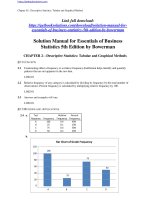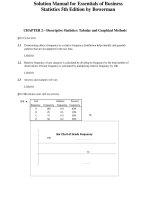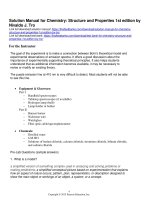Solution manual for financial markets and institutions 5th edition by saunders
Bạn đang xem bản rút gọn của tài liệu. Xem và tải ngay bản đầy đủ của tài liệu tại đây (46.07 KB, 6 trang )
Full file at />
SOLUTIONS MANUAL
Chapter One
Answers to Chapter 1
Questions:
1.
a. primary
b. primary
c. secondary
d. secondary
e. secondary
2.
a. money market
b. money market
c. capital market
d. capital market
e. capital market
f. money market
g. money market
h. money market
i. capital market
j. money market
3. The capital markets are more likely to be characterized by actual physical locations such as the
New York Stock Exchange or the American Stock Exchange. Money market transactions are
more likely to occur via telephone, wire transfers, and computer trading.
4. According to Figure 1-3, the money market instrument that has had the largest growth is the
Federal funds and repurchase agreements which grew from 18.1% of the total value of money
market securities outstanding in 1990 to 25.6% in 2010.
5. The major instruments traded in capital markets are corporate stocks, securitized mortgages,
corporate bonds, Treasury notes and bonds, state and local government bonds, U.S. government
owned and sponsored agencies, and bank and consumer loans.
6. According to Figure 1-4, the capital market instrument that has had the largest growth is the
corporate stocks which grew from 23.6% of the total value of money market securities
outstanding in 1990 to 43.4% in 2000 and was still at 31/3% in 2010. One reason for the sharp
increase in the amount of equities outstanding is the bull market in stock prices in the 1990s.
Stock values fell in the early 2000s as the U.S. economy experienced a downturn—partly
because of 9-11 and partly because interest rates began to rise―and stock prices fell. Stock
prices in most sectors subsequently recovered and, by 2007, even surpassed their 1999 levels.
Stock prices fell precipitously in during the financial crisis of 2008-2009. As of mid-March 2009,
the Dow Jones Industrial Average (DJIA) had fallen in value 53.8 percent in less than 1 ½ year’s
time, larger than the
buy this full document at
Full file at />
decline during the market crash of 1937-1938 when it fell 49 percent. However, stock prices
recovered along with the economy in the last half of 2009, rising 71.1 percent between March
2009 and April 2010.
7. The bank would fear a depreciation of the yen against the dollar.
8. Financial institutions consist of:
Commercial banks - depository institutions whose major assets are loans and major liabilities are
deposits. Commercial banks’ loans are broader in range, including consumer, commercial, and
real estate loans, than other depository institutions. Commercial banks’ liabilities include more
nondeposit types of nondeposit sources of funds, such as subordinate notes
and
debentures, than other depository institutions.
Thrifts - depository institutions in the form of savings and loans, savings banks, and credit
unions. Thrifts generally perform services similar to commercial banks, but they tend to
concentrate their loans in one segment, such as real estate loans or consumer loans.
Insurance companies - financial institutions that protect individuals and corporations
(policyholders) from adverse events. Life insurance companies provide protection in the event of
untimely death, illness, and retirement. Property casualty insurance protects against personal
injury and liability due to accidents, theft, fire, etc.
Securities firms and investment banks - financial institutions that underwrite securities and
engage in related activities such as securities brokerage, securities trading, and making a market
in which securities can trade.
Finance companies - financial intermediaries that make loans to both individual and businesses.
Unlike depository institutions, finance companies do not accept deposits but instead rely on
short- and long-term debt for funding.
Mutual funds - financial institutions that pool financial resources of individuals and companies
and invest those resources in diversified portfolios of asset.
Pension funds - financial institutions that offer savings plans through which fund participants
accumulated savings during their working years before withdrawing them during their retirement
years. Funds originally invested in and accumulated in a pension fund are exempt from current
taxation.
9. If there were no FIs then the users of funds, such as corporations in the economy, would have
to approach the savers of funds, such as households, directly in order to fund their investment
projects and fill their borrowing needs. This would be extremely costly because of the up-front
information costs faced by potential lenders. These include costs associated with identifying
potential borrowers, pooling small savings into loans of sufficient size to finance corporate
activities, and assessing risk and investment opportunities. Moreover, lenders would have to
monitor the activities of borrowers over each loan's life span, which is compounded by the free
buy this full document at
Full file at />
rider problem. The net result is an imperfect allocation of resources in an economy.
10. There are at least three reasons for this. First, once they have lent money in exchange for
financial claims, suppliers of funds need to monitor or check the use of their funds. They must be
sure that the user of funds neither absconds with nor wastes the funds on projects that have low
or negative returns, since this would lower the chances of being repaid and/or earning a positive
income on their investment (such as dividends or interest). Such monitoring actions are often
extremely costly for any given fund supplier because they require considerable time, expense,
and effort to collect this information relative to the size of the average fund supplier’s
investment.
Second, the relatively long-term nature of some financial claims (e.g., mortgages, corporate
stock, and bonds) creates a second disincentive for suppliers of funds to hold the direct financial
claims issued by users of funds. Specifically, given the choice between holding cash and
long-term securities, fund suppliers may well choose to hold cash for liquidity reasons,
especially if they plan to use savings to finance consumption expenditures in the near future and
financial markets are not very deep in terms of active buyers and sellers.
Third, even though real-world financial markets provide some liquidity services, by allowing
fund suppliers to trade financial securities among themselves, fund suppliers face a price risk
upon the sale of securities. In addition, the secondary market trading of securities involves
various transaction costs. The price at which investors can sell a security on secondary markets
such as the New York Stock Exchange (NYSE) may well differ from the price they initially paid
for the security either because investors change their valuation of the security between the time it
was bought and when it was sold and/or because dealers, acting as intermediaries between
buyers and sellers, charge transaction costs for completing a trade.
11. A suppler of funds who directly invests in a fund user’s financial claims faces a high cost of
monitoring the fund user’s actions in a timely and complete fashion after purchasing securities.
One solution to this problem is for a large number of small investors to place their funds with a
single FI serving as a broker between the two parties. When acting as a pure broker, the FI acts
as an agent for the fund suppliers in providing information about the fund users. The FI groups
the fund suppliers’ funds together and invests them in the direct or primary financial claims
issued by fund users. This aggregation of funds resolves a number of problems. First, the large FI
now has a much greater incentive to collect information and monitor the fund user’s actions
because the FI has far more at stake than any small individual fund supplier. This alleviates the
problem that exists when small fund suppliers leave it to each other to collect information and
monitor a fund user’s use of the funds it raises. In a sense, fund suppliers have appointed the FI
as a delegated monitor to act on their behalf.
buy this full document at
12. In addition to information costs, FIs also help small savers alleviate liquidity risk. Liquidity
risk occurs when savers are not able to sell their securities at demand. Commercial banks, for
example, are able to offer deposits that can be withdrawn at any time. Yet they are able to make
long-term loans or invest in illiquid assets because of two reasons: 1) they are able to diversify
their portfolios; 2) they are able to better monitor the performance of firms that have been given
the loans or who have issued securities. The less diversified the assets of the FI, the more likely it
will hold illiquid assets.
13. As long as the returns on different investments are not perfectly positively correlated, by
spreading their investments across a number of assets, FIs can diversify away significant
amounts of their portfolio risk. Further, for equal investments in different securities, as the
number of securities in an FI’s asset portfolio increases portfolio risk falls, albeit at a diminishing
rate. What is really going on here is that FIs can exploit the law of large numbers in making their
investment decisions, whereas due to their smaller wealth size, individual fund suppliers are
constrained to holding relatively undiversified portfolios. As a result, diversification allows an FI
to predict more accurately its expected return and risk on its investment portfolio so that it can
credibly fulfill its promises to the suppliers of funds to provide highly liquid claims with little
price risk. A good example of this is a bank’s ability to offer highly liquid, instantly
withdrawable demand deposits as liabilities while investing in risky, nontradable, and often
illiquid loans as assets. As long as an FI is sufficiently large, to gain from diversification and
monitoring on the asset side of its balance sheet, its financial claims (it issues as liabilities) are
likely to be viewed as liquid and attractive to small savers, especially when compared to direct
investments in the capital market. A mutual fund invested in a diverse group of stocks and fixed
income securities will best provide diversification for an investor.
14. If net borrowers and net lenders have different optimal time horizons, FIs can service both
sectors by matching their asset and liability maturities. That is, the FI can offer the relatively
short-term liabilities desired by households (say, in the form of bank deposits) and also satisfy
the demand for long-term loans (say, in the form of home mortgages). By investing in a portfolio
of long-and short-term assets and liabilities, the FI can both reduce risk exposure through
diversification and manage risk exposure by centralizing its hedging activities.
15. Because they are sold in very large denominations, many assets are either out of reach of
individual savers or would result in savers holding highly undiversified asset portfolios. For
example, the minimum size of a negotiable CD is $100,000; commercial paper (short-term
corporate debt) is often sold in minimum packages of $250,000 or more. Individual savers may
be unable to purchase such instruments directly. However, by buying shares in a mutual fund
with other small investors, household savers overcome the constraints to buying assets imposed
by large minimum denomination sizes. Such indirect access to these markets may allow small
savers to generate higher returns on their portfolios as well.
16. Other services provided by FIs that benefit the overall economy include:
Money Supply Transmission - Depository institutions are the conduit through which monetary
policy actions impact the rest of the financial system and the economy in general.
Credit Allocation - FIs are often viewed as the major, and sometimes only, source of financing
for a particular sector of the economy, such as farming and residential real estate.
Intergenerational Wealth Transfers - FIs, especially life insurance companies and pension funds,
provide savers the ability to transfer wealth from one generation to the next.
Payment Services - The efficiency with which depository institutions provide payment services
directly benefits the economy.
17. FIs provide various services to sectors of the economy. Failure to provide these services, or a
breakdown in their efficient provision, can be costly to both the ultimate suppliers (households)
and users (firms) of funds as well as the overall economy. For example, bank failures may
destroy household savings and at the same time restrict a firm’s access to credit. Insurance
company failures may leave households totally exposed in old age to catastrophic illnesses and
sudden drops in income on retirement. In addition, individual FI failures may create doubts in
savers’ minds regarding the stability and solvency of FIs in general and cause panics and even
runs on sound institutions. FIs are regulated in an attempt to prevent these types of market
failures.
18. A major event that changed and reshaped the financial services industry was the financial
crisis of the late 2000s. As FIs adjusted to regulatory changes brought about by the likes of the
FSM Act, one result was a dramatic increase in systemic risk of the financial system, caused in
large part by a shift in the banking model from that of “originate and hold” to “originate to
distribute.” In the traditional model, banks take short term deposits and other sources of funds
and use them to fund longer term loans to businesses and consumers. Banks typically hold these
loans to maturity, and thus have an incentive to screen and monitor borrower activities even after
a loan is made. However, the traditional banking model exposes the institution to potential
liquidity, interest rate, and credit risk. In attempts to avoid these risk exposures and generate
improved return-risk tradeoffs, banks shifted to an underwriting model in which they originated
or warehoused loans, and then quickly sold them. Indeed, most large banks organized as
financial service holding companies to facilitate these new activities. These innovations removed
risk from the balance sheet of financial institutions and shifted risk off the balance sheet and to
other parts of the financial system. Since the FIs, acting as underwriters, were not exposed to the
credit, liquidity, and interest rate risks of traditional banking, they had little incentive to screen
and monitor activities of borrowers to whom they originated loans. Thus, FIs failed to act as
specialists in risk measurement and management.
19. The boom (“bubble”) in the housing markets began building in 2001, particularly after the
terrorist attacks of 9/11. The immediate response by regulators to the terrorist attacks was to
create stability in the financial markets by providing liquidity to FIs. For example, the Federal
Reserve lowered the short-term money market rate that banks and other financial institutions pay
in the Federal funds market and even made lender of last resort funds available to non-bank FIs
such as investment banks. Perhaps not surprisingly, low interest rates and the increased liquidity
provided by Central banks resulted in a rapid expansion in consumer, mortgage, and corporate
debt financing. Demand for residential mortgages and credit card debt rose dramatically. As the
demand for mortgage debt grew, especially among those who had previously been excluded from
participating in the market because of their poor credit ratings, FIs began lowering their credit
quality cut-off points. Moreover, to boost their earnings, in the market now popularly known as
the “subprime market,” banks and other mortgage-supplying institutions often offered relatively
low “teaser” rates on adjustable rate mortgages (ARMs) at exceptionally low initial interest rates,
but with substantial step-up in rates after the initial rate period expired two or three year later and
if market rates rose in the future. Under the traditional banking structure, banks might have been
reluctant to so aggressively pursue low credit quality borrowers for fear that the loans would
default. However, under the originate-to-distribute model of banking, asset securitization and
loan syndication allowed banks to retain little or no part of the loans, and hence the default risk
on loans that they originated. Thus, as long as the borrower did not default within the first
months after a loan’s issuance and the loans were sold or securitized without recourse back to the
bank, the issuing bank could ignore longer term credit risk concerns. The result was deterioration
in credit quality, at the same time as there was a dramatic increase in consumer and corporate
leverage.
20. Measured as more than $1trillion in international debt outstanding the biggest issuers are
France, Germany, Italy, the Netherlands, Spain, the United Kingdom, and the United States.
21. France, Germany, Japan, Switzerland, the United Kingdom, and the United States have the
biggest banks (in terms of total assets).









